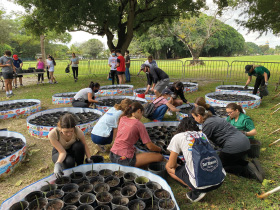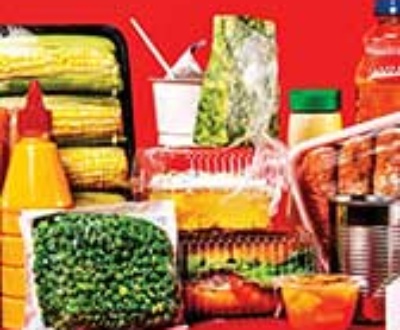I’m writing this the first week in January, in the middle of another covid surge. I guess there’s no predicting what comes next, but when the thing eventually dies down again I sure plan to get out and play a lot!
Coral Gables Farmers Market Garden Talks
I hope you have been able to get to some Farmers Markets this year, in addition to all the fun things to buy and enjoy we’ve been doing some great garden talks at the market. They started January 15 with “Best Pollinator Plants for Miami Dade County” and three native nurseries to buy plants from, followed by “Native Plants for Florida Gardens” and “Biodiversity and Conservation”. Talks start at 9 am at the market.
In February we have our own Commissioner Rhonda Anderson on “Red Mangroves: Coastal Barrier and Nursery for Fish and Butterflies”, 2/5, and Dr. Lina Mueller, Professor of Biology, University of Miami on “Fabulous Fungi” 2/12. The Market and the talks continue through March 26 so come out and enjoy!
Red Mangroves

A mangrove forest. (Photo by Lydia Cunia)
Red Mangroves are those mangroves in our waters that sit high up on their roots. Along with seagrasses, mangroves are among the very small number of flowering plants that can survive in a marine environment. There are actually more than 50 tropical and subtropical shrubs and trees worldwide, classified as mangroves, that have evolved adaptations that allow them to survive and reproduce in fresh and salt water.
Red mangroves, according to the Nature Conservancy, are a keystone species. A keystone species is one which has a disproportionately large effect on its environment.
They play a critical role in maintaining the structure of an ecological community.
So what are the many functions that red mangroves provide that make it a keystone species? 1) Mangroves are land superheroes. They protect shorelines from storms by absorbing the wind and wave energy and their tangled root systems hold the soil in place during changing tides and weather events. 2) Mangroves filter the water, absorbing nitrates and ammonia, and sequester carbon 3) Mangroves provide shelter for a wide variety of birds, insects, spiders, crustacean and mammals. Their roots act like nurseries for hundreds of marine animal species and oysters-which also remove pollutants from the water- attach to their roots. They form the basis of a massive Food web.
Coral Gables and Red Mangroves

A group of volunteers who planted the mangrove pups. (Photo by Grace Carricarte)
The Coral Gables Garden Club started a project with red mangroves that has now become and “all hands on deck” project with the Club, the City, the Scouts and many volunteers all involved. During high tides (our King tides) some mangrove propagules (baby trees) that germinate while attached to the parent tree wash up on land. The volunteers picked up mangrove pups from flooded parking lots and bike paths. The healthy propagules are replanted in pots in circular kids swimming pools, to replicate their natural environment, near the Scout hut on the Granada Golf course.
On Saturday, January 8th over 100 volunteers showed up at the hut to plant 1300 pups in pots! The City is setting up up a water pump circulation system for the pools and the Scouts will check the water levels weekly. When they get to the right size they will be replanted on our shoreline. Good Stuff Right?!
More Good Stuff
So destructive is the water hyacinth plant to lakes and rivers in Africa that fisherman call it the curse. When Divin Kouebatouka returned to his mother’s village on the banks of Lake Djoue in the Congo after studying engineering at Colorado State University, he saw an invasive plant that was asphyxiating the fish and blocking marine navigation.
So he studied the properties of water hyacinth and found that it is rich in nitrate which is good for compost, rich in protein which is good for animal feed, and it has a high absorbency. Now fishing is how the people in his village live. And the Congo has large reserves of oil and gas and oil spills are common.
So he turned a botanical problem into a solution for an environmental problem and has provided employment for 900 water hyacinth collectors, 80% of whom are women.
His Green Team Africa developed a way to turn the plants stems into highly absorbent fibre that can suck up oil from the ground or water or plug a leak in an oil container.
Today more that 10 companies buy the product called Kukia, which can hold more than 17 times its weight in hydrocarbons. The roots are composted and the leaves are turned into animal feed. AND once the stem fibre has been used in a oil spill or a leak, it can be repurposed as a fuel source by cement factories, he says...
Even the Bugs Are Helping Out
It turns out that microbes in oceans and soils are evolving to eat plastic. Unfortunately millions of tons of plastic are dumped into the environment every year and according to the journal, Microbial Ecology (article link), scientists have discovered 12,000 new plastic eating enzymes in the ocean and 18,000 plastic eating enzymes in the soil taken from sites all around the globe. Little by little right?
About the Author

Linda Lawrence Waldron currently writes the Green Gables column in Gables Living Magazine. Linda was Chairman of the Garden Club's Coral Gables Library Butterfly Garden Committee.
Sign up here for email notifications about new Green Gables articles!
More from our blogs
See all postsRecent Posts
- April 2023 April 1, 2024
- Good News on Environmental Plastics February 1, 2024
- Material World / Plant World January 1, 2024
Leave a Comment cancel
This site uses Akismet to reduce spam. Learn how your comment data is processed.









